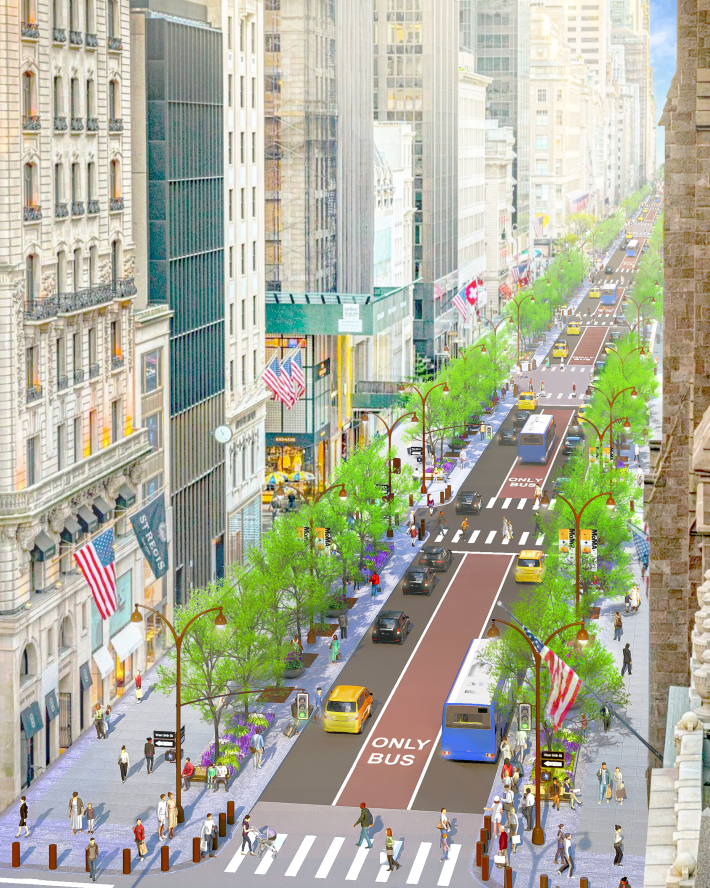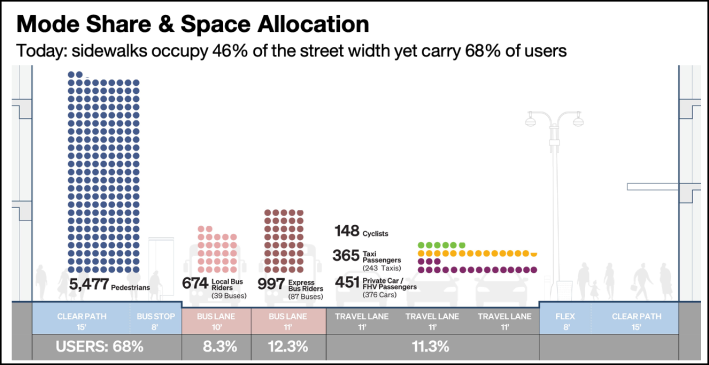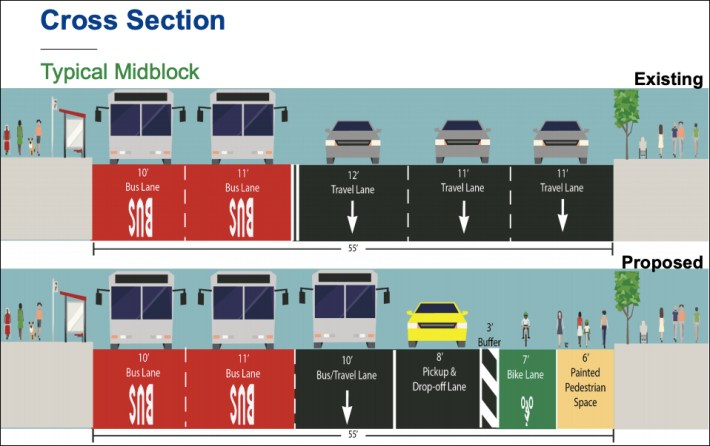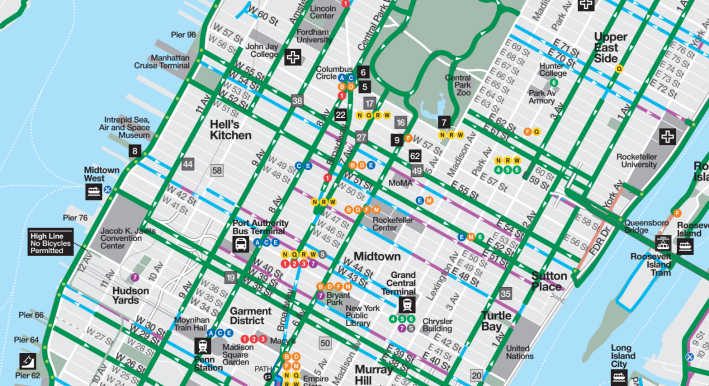Mayor Adams wants to increase pedestrian space on Fifth Avenue in Midtown, but his plan calls for removing one of the two bus lanes — and eliminates a proposed protected bike lane, the city announced on Thursday.
The overhaul — cooked up with with business leaders — is not slated to start construction until 2028, well after the mayor's term, and will increase pedestrian space by 46 percent. But, crucially, it takes space from bus riders, who were promised four years ago by the de Blasio administration that they would no longer have to share any roadway space with through traffic.
The former mayor had already watered down that proposal after pushback from mom-and-pop shops like Armani, Dolce and Gabbana, and Tiffany and Co., but Adams's latest redraw as yet another step back for the more than 110,000 daily bus riders across 40 routes that sit in clogged traffic on Fifth Avenue, advocates said.
"It’s surrender," said Danny Pearlstein, a spokesman for Riders Alliance. "The importance of Fifth Avenue as a transit corridor is minimized in this plan with no equitable justification at all."
Mayor Adams in late 2022 brought in local bigwigs to work on a new plan, showing off renderings with two bus lanes, a protected bike lane, wider sidewalks, and just one lane for private cars:

The new draft plan — created in partnership with the Fifth Avenue Association, Grand Central Partnership, Central Park Conservancy and Bryant Park Corporation — still adds about 10 feet to each of the 23-foot-wide sidewalks by reducing the vehicle lanes from a total of five to three between Central and Bryant parks. That gives more space to pedestrians, who make up 68 percent of people on the avenue, but currently get less than half of the 100-foot-wide public right-of-way.

The city chose to eliminate one of the three car lanes and one of the two bus lanes, leaving drivers with two-thirds of the road — even though bus riders make up 63 percent of road users, according to data by the Fifth Avenue Association.
Advocates praised the extra space, but questioned why the majority of the road was still going to private cars, who make up a minority of people on Fifth Avenue.
"Bus riders deserve a route where they can have full priority with no cars in the way," said Samir Lavingia, the vice chair of the Community Board 5 Traffic and Environment Committee, who spoke to Streetsblog in a personal capacity. "Frankly, this plan feels like a 1990s vision for Fifth Avenue and we deserve a plan for decades to come."
The overhaul will cost a whopping $350 million and won't start construction for more than three years. Painting a busway, as the city has done successfully on corridors like 14th Street and 181st Street, could have been done within weeks and at low cost.

The rationale for removing a bus lane is that drivers already intruded on the existing curbside bus path, because they were allowed to use it to to turn off, according to the Times, which first reported the plans. So officials plan to revert that outer path into a "shared lane" — which has no red paint in the renderings and appears to be a regular car lane in all but name.
Unlike the poohbahs that brokered the latest deal with Adams, bus riders tend to be overwhelmingly lower-income and people of color.

A spokesman for the state's Metropolitan Transportation Authority, which runs the buses, said it was still reviewing the plans but stressed the need for maintaining bus priority on the outside lane as well.
"Buses are the engine of transportation equity in New York and a proven effective tool for speeding up buses is dedicated bus lanes," said Aaron Donovan in a statement. "The MTA is reviewing this plan and looks forward to working with the city to ensure priority for buses is maintained in the right side lane."
Representatives for the Fifth Avenue Association, the powerful business group that helped draft the plans, said the main goal is to expand space for the 5,477 pedestrians per hour that use the corridor, a rate that balloons nearly five-fold to around 23,000 per hour during the busy holiday period.
The city removed cars entirely from 11 blocks of Fifth Avenue for holiday shoppers during three Sundays in December last year and the year before. The first year, the car-free zone boosted spending by $3 million, a 6.6-percent bump, according to a study by MasterCard and the city at the time.
After pedestrians, the next-largest group is the 1,671 hourly local and express bus riders, who will now get less space than the 816 people driving next to them in private cars, taxis, and Uber or Lyfts. The Association's numbers don't break out personal cars from for-hire vehicles.
There are also 148 cyclists that pass through each hour, who will not have any safe space, a huge loss from the renderings Adams touted nearly two years ago.
The city plans to turn the northbound protected bike lane on Sixth Avenue into a two-way path at some point, but to cycling boosters that's not enough, and the city should still provide space on Fifth Avenue as well, especially given the dearth of safe north-south paths on the East Side of Midtown.

"We shouldn’t have to choose space for bikes and space for pedestrians or bus riders — we can and should have all of the above. Space for everyone means safety for everyone," said Transportation Alternatives Interim Co-Executive Director Elizabeth Adams. "This much-needed transformation of Fifth Avenue is a step in the right direction, but it’s not enough."
Cyclists will likely still go down Fifth and just hop on the sidewalk, if that's the only safe space for them to ride, Lavingia said.
"The city should not be surprised when bike riders end up on the sidewalks," he said. "I'm not convinced that a two-way bike lane on Sixth Avenue will meet the demand we'll see for bikes on the East side of Manhattan."
The backpedal follows a familiar pattern in the Adams Administration, which has sided with big business interests against the Fordham Road bus improvements, and the bike lanes on McGuinness Boulevard and Ashland Place.
Adams has also repeatedly come in well below the minimum required miles of new protected bus and bike lanes under the city's 2019 Streets Plan law.
City Hall did not respond for comment.
There will be a presentation and open house about the new Fifth Avenue design on Oct. 29, 6-8 p.m. at the CUNY Graduate Center, 365 Fifth Avenue. RSVP here.






